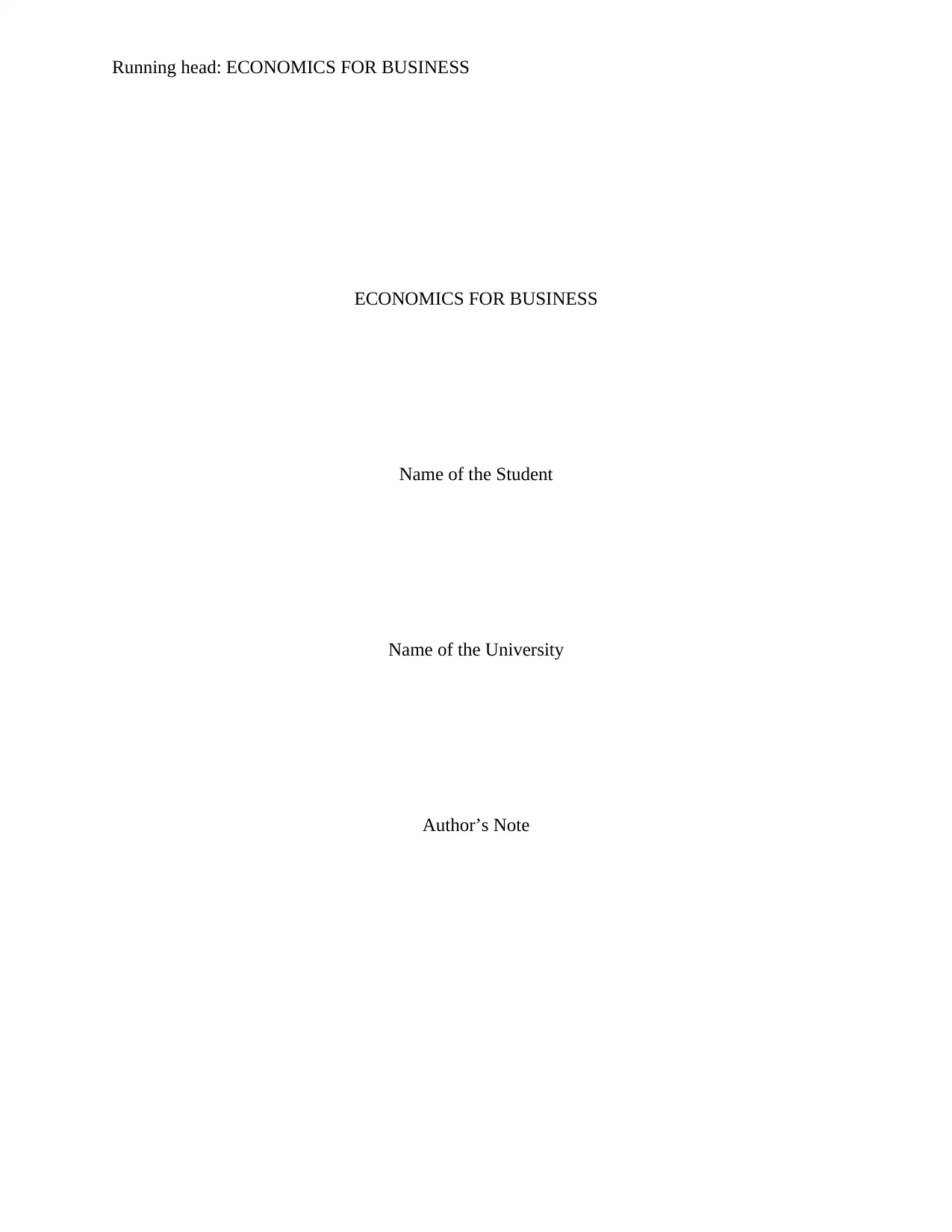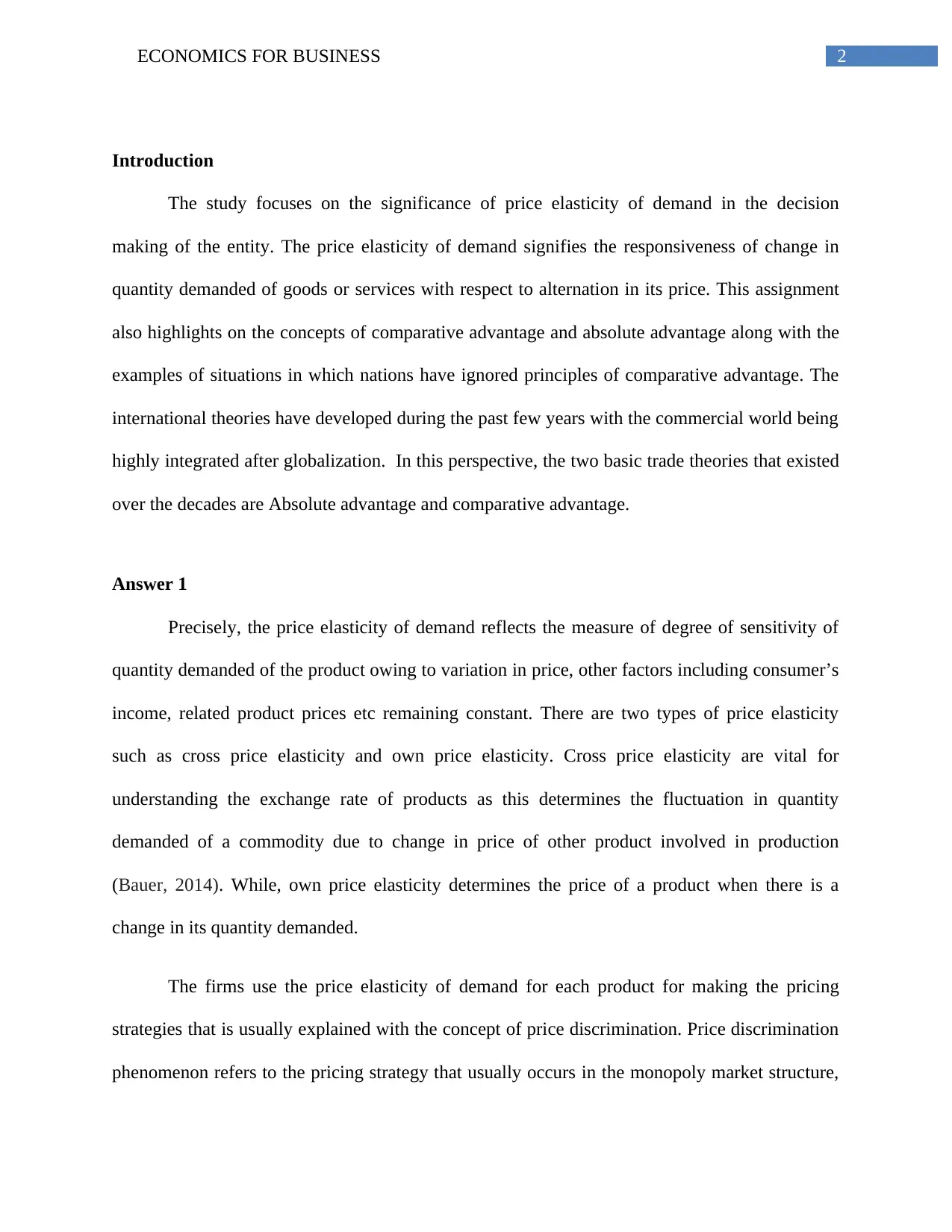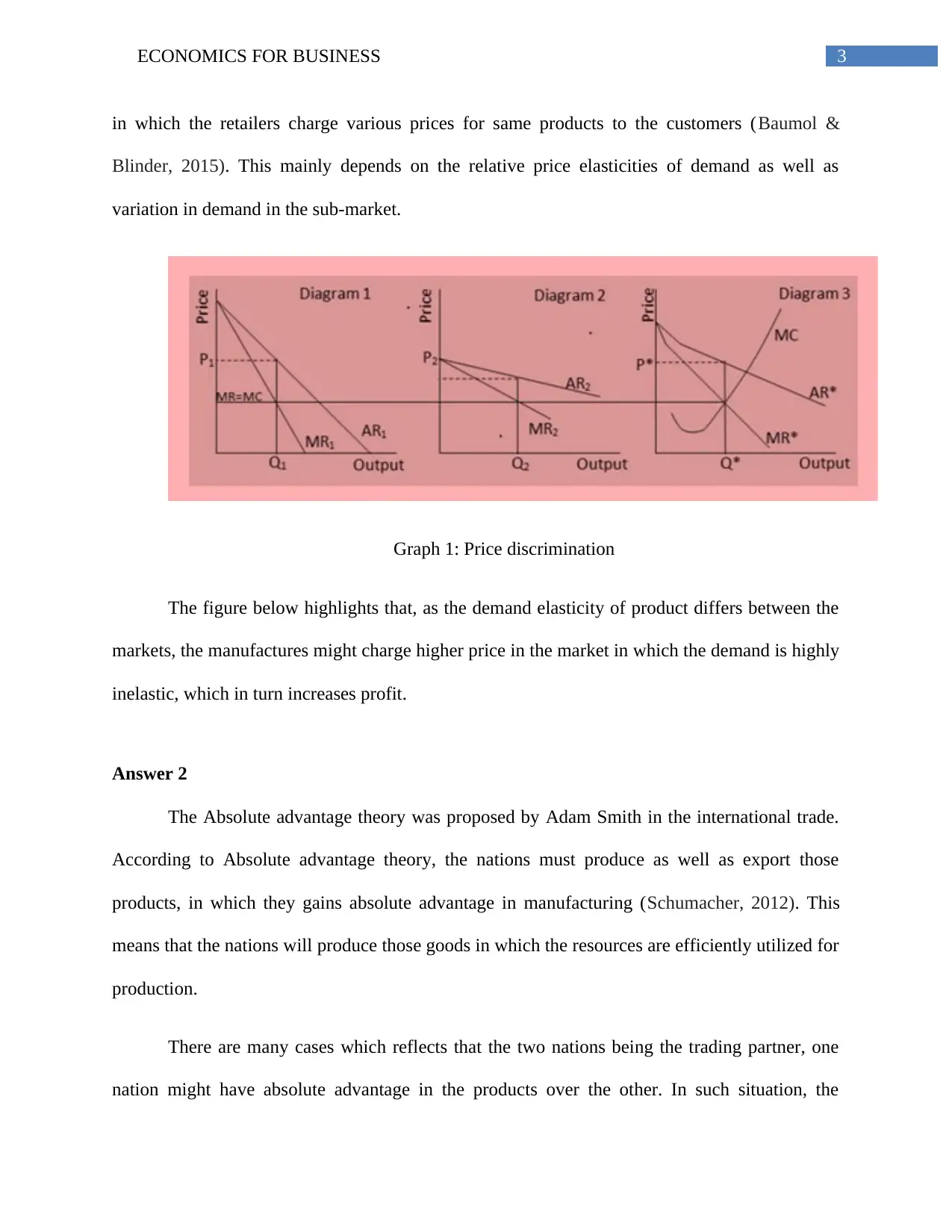Economics for Business: Analyzing Price Elasticity and Trade Theories
VerifiedAdded on 2020/04/13
|6
|793
|38
Homework Assignment
AI Summary
This assignment delves into the economic concepts of price elasticity of demand, comparative advantage, and absolute advantage within a business context. It begins by defining price elasticity of demand, differentiating between cross-price and own-price elasticity, and explaining its significance in pricing strategies, particularly in the context of price discrimination. The assignment then explores the theories of absolute and comparative advantage in international trade, highlighting how nations can benefit from specialization. It provides examples and discusses situations where nations might not fully utilize their comparative advantages. The conclusion summarizes the importance of these economic concepts for business decision-making, emphasizing how understanding price elasticity and trade theories can help companies maximize profits and navigate the global market.

Running head: ECONOMICS FOR BUSINESS
ECONOMICS FOR BUSINESS
Name of the Student
Name of the University
Author’s Note
ECONOMICS FOR BUSINESS
Name of the Student
Name of the University
Author’s Note
Paraphrase This Document
Need a fresh take? Get an instant paraphrase of this document with our AI Paraphraser

1ECONOMICS FOR BUSINESS
Table of contents
Introduction......................................................................................................................................3
Answer 1..........................................................................................................................................3
Answer 2..........................................................................................................................................4
Conclusion.......................................................................................................................................5
References........................................................................................................................................6
Table of contents
Introduction......................................................................................................................................3
Answer 1..........................................................................................................................................3
Answer 2..........................................................................................................................................4
Conclusion.......................................................................................................................................5
References........................................................................................................................................6

2ECONOMICS FOR BUSINESS
Introduction
The study focuses on the significance of price elasticity of demand in the decision
making of the entity. The price elasticity of demand signifies the responsiveness of change in
quantity demanded of goods or services with respect to alternation in its price. This assignment
also highlights on the concepts of comparative advantage and absolute advantage along with the
examples of situations in which nations have ignored principles of comparative advantage. The
international theories have developed during the past few years with the commercial world being
highly integrated after globalization. In this perspective, the two basic trade theories that existed
over the decades are Absolute advantage and comparative advantage.
Answer 1
Precisely, the price elasticity of demand reflects the measure of degree of sensitivity of
quantity demanded of the product owing to variation in price, other factors including consumer’s
income, related product prices etc remaining constant. There are two types of price elasticity
such as cross price elasticity and own price elasticity. Cross price elasticity are vital for
understanding the exchange rate of products as this determines the fluctuation in quantity
demanded of a commodity due to change in price of other product involved in production
(Bauer, 2014). While, own price elasticity determines the price of a product when there is a
change in its quantity demanded.
The firms use the price elasticity of demand for each product for making the pricing
strategies that is usually explained with the concept of price discrimination. Price discrimination
phenomenon refers to the pricing strategy that usually occurs in the monopoly market structure,
Introduction
The study focuses on the significance of price elasticity of demand in the decision
making of the entity. The price elasticity of demand signifies the responsiveness of change in
quantity demanded of goods or services with respect to alternation in its price. This assignment
also highlights on the concepts of comparative advantage and absolute advantage along with the
examples of situations in which nations have ignored principles of comparative advantage. The
international theories have developed during the past few years with the commercial world being
highly integrated after globalization. In this perspective, the two basic trade theories that existed
over the decades are Absolute advantage and comparative advantage.
Answer 1
Precisely, the price elasticity of demand reflects the measure of degree of sensitivity of
quantity demanded of the product owing to variation in price, other factors including consumer’s
income, related product prices etc remaining constant. There are two types of price elasticity
such as cross price elasticity and own price elasticity. Cross price elasticity are vital for
understanding the exchange rate of products as this determines the fluctuation in quantity
demanded of a commodity due to change in price of other product involved in production
(Bauer, 2014). While, own price elasticity determines the price of a product when there is a
change in its quantity demanded.
The firms use the price elasticity of demand for each product for making the pricing
strategies that is usually explained with the concept of price discrimination. Price discrimination
phenomenon refers to the pricing strategy that usually occurs in the monopoly market structure,
⊘ This is a preview!⊘
Do you want full access?
Subscribe today to unlock all pages.

Trusted by 1+ million students worldwide

3ECONOMICS FOR BUSINESS
in which the retailers charge various prices for same products to the customers (Baumol &
Blinder, 2015). This mainly depends on the relative price elasticities of demand as well as
variation in demand in the sub-market.
Graph 1: Price discrimination
The figure below highlights that, as the demand elasticity of product differs between the
markets, the manufactures might charge higher price in the market in which the demand is highly
inelastic, which in turn increases profit.
Answer 2
The Absolute advantage theory was proposed by Adam Smith in the international trade.
According to Absolute advantage theory, the nations must produce as well as export those
products, in which they gains absolute advantage in manufacturing (Schumacher, 2012). This
means that the nations will produce those goods in which the resources are efficiently utilized for
production.
There are many cases which reflects that the two nations being the trading partner, one
nation might have absolute advantage in the products over the other. In such situation, the
in which the retailers charge various prices for same products to the customers (Baumol &
Blinder, 2015). This mainly depends on the relative price elasticities of demand as well as
variation in demand in the sub-market.
Graph 1: Price discrimination
The figure below highlights that, as the demand elasticity of product differs between the
markets, the manufactures might charge higher price in the market in which the demand is highly
inelastic, which in turn increases profit.
Answer 2
The Absolute advantage theory was proposed by Adam Smith in the international trade.
According to Absolute advantage theory, the nations must produce as well as export those
products, in which they gains absolute advantage in manufacturing (Schumacher, 2012). This
means that the nations will produce those goods in which the resources are efficiently utilized for
production.
There are many cases which reflects that the two nations being the trading partner, one
nation might have absolute advantage in the products over the other. In such situation, the
Paraphrase This Document
Need a fresh take? Get an instant paraphrase of this document with our AI Paraphraser

4ECONOMICS FOR BUSINESS
comparative advantage theory fills the gap of previous trade theory. The comparative advantage
proposed by David Ricardo defines that the nation might produce as well as export those goods
in which it manufactures at less opportunity cost than other nations (Laursen, 2015). Moreover,
there are various nations where despite having comparative advantages in few industry might
not utilize it. For example, China having enormous comparative advantage in labor intensive
goods, does not use them and hence exports capital intensive goods.
Conclusion
From the above assignment, it can be seen that the comparative advantage theory has
been considered as one of the integrating as well as inclusive trade theories. In addition, few
nations despite having comparative advantage do not use it in several circumstances.
Furthermore, the above study also shows that price elasticity of demand has been considered as
one of decisive factors of companies for making pricing strategies. Thus, appropriate utilization
of this economic concept might facilitate the companies in maximizing the profit margin.
comparative advantage theory fills the gap of previous trade theory. The comparative advantage
proposed by David Ricardo defines that the nation might produce as well as export those goods
in which it manufactures at less opportunity cost than other nations (Laursen, 2015). Moreover,
there are various nations where despite having comparative advantages in few industry might
not utilize it. For example, China having enormous comparative advantage in labor intensive
goods, does not use them and hence exports capital intensive goods.
Conclusion
From the above assignment, it can be seen that the comparative advantage theory has
been considered as one of the integrating as well as inclusive trade theories. In addition, few
nations despite having comparative advantage do not use it in several circumstances.
Furthermore, the above study also shows that price elasticity of demand has been considered as
one of decisive factors of companies for making pricing strategies. Thus, appropriate utilization
of this economic concept might facilitate the companies in maximizing the profit margin.

5ECONOMICS FOR BUSINESS
References
Bauer, M. J. R. (2014). Principles of microeconomics.
Baumol, W. J., & Blinder, A. S. (2015). Microeconomics: Principles and policy. Cengage
Learning.
Laursen, K. (2015). Revealed comparative advantage and the alternatives as measures of
international specialization. Eurasian Business Review, 5(1), 99-115.
Schumacher, R. (2012). Adam Smith's theory of absolute advantage and the use of doxography
in the history of economics. Erasmus Journal for Philosophy and Economics, 5(2), 54-80.
References
Bauer, M. J. R. (2014). Principles of microeconomics.
Baumol, W. J., & Blinder, A. S. (2015). Microeconomics: Principles and policy. Cengage
Learning.
Laursen, K. (2015). Revealed comparative advantage and the alternatives as measures of
international specialization. Eurasian Business Review, 5(1), 99-115.
Schumacher, R. (2012). Adam Smith's theory of absolute advantage and the use of doxography
in the history of economics. Erasmus Journal for Philosophy and Economics, 5(2), 54-80.
⊘ This is a preview!⊘
Do you want full access?
Subscribe today to unlock all pages.

Trusted by 1+ million students worldwide
1 out of 6
Related Documents
Your All-in-One AI-Powered Toolkit for Academic Success.
+13062052269
info@desklib.com
Available 24*7 on WhatsApp / Email
![[object Object]](/_next/static/media/star-bottom.7253800d.svg)
Unlock your academic potential
Copyright © 2020–2025 A2Z Services. All Rights Reserved. Developed and managed by ZUCOL.





